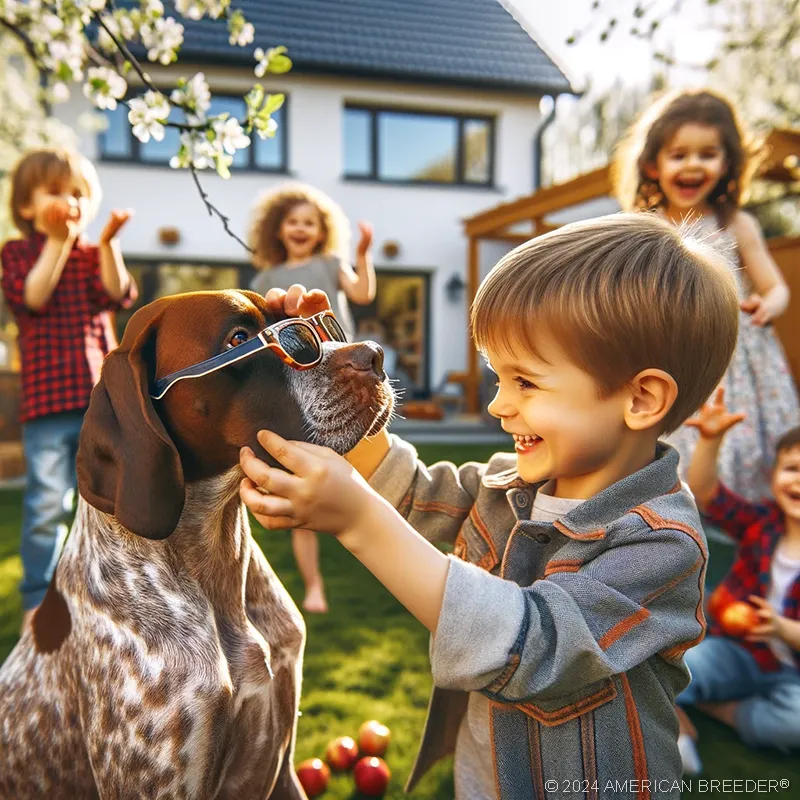Embracing the Energetic Charm of the German Shorthaired Pointer
Introduction and Breed Background
 Welcome to the captivating world of the German Shorthaired Pointer Dog! This remarkable breed has charmed dog lovers with its intelligence, athleticism, and loyal nature. In this comprehensive guide, we will delve into every aspect of the German Shorthaired Pointer, from its fascinating history to its unique characteristics, making this a must-read for anyone considering this breed as a companion.
Welcome to the captivating world of the German Shorthaired Pointer Dog! This remarkable breed has charmed dog lovers with its intelligence, athleticism, and loyal nature. In this comprehensive guide, we will delve into every aspect of the German Shorthaired Pointer, from its fascinating history to its unique characteristics, making this a must-read for anyone considering this breed as a companion.
Brief Summary Description of the German Shorthaired Pointer Dog
The German Shorthaired Pointer, also known as GSP, is a versatile and highly athletic breed that hails from Germany. Bred for its keen hunting instincts and ability to work both on land and in water, this breed has become a favorite among hunters and active families alike. With its sleek, muscular build and striking coat, the GSP commands attention and embodies the essence of a true sporting dog.
Considerations Before Choosing the German Shorthaired Pointer Dog
Before bringing a German Shorthaired Pointer into your life, there are several essential factors to consider. This breed thrives on physical activity and mental stimulation, making it unsuitable for those with a sedentary lifestyle. Potential owners should be prepared to invest time and effort in training and exercise to keep this intelligent breed content and well-behaved.
Interesting Facts and Fun Facts about the German Shorthaired Pointer Dog
The German Shorthaired Pointer is known by various names across the globe. In Germany, it is called "Deutsch Kurzhaar," reflecting its country of origin. In some regions, it is simply referred to as the "Shorthair" or "GSP." Within families and communities, the German Shorthaired Pointer has earned several endearing nicknames. Enthusiastic owners often call them "Velcro dogs" due to their strong bond with their human companions. Their playful nature has also earned them the moniker "Fur Missile."
Breed Background and History
Origin and Development of the German Shorthaired Pointer Dog
The German Shorthaired Pointer's history dates back to the 19th century when German hunters sought to develop an all-around hunting dog capable of tracking, pointing, and retrieving game. By selectively breeding various hunting breeds, including the Spanish Pointer, the English Pointer, and the Foxhound, they created the versatile GSP we know today.
Historical Significance or Cultural Relevance
Throughout its history, the German Shorthaired Pointer played a vital role in hunting and assisting hunters in Europe and beyond. Its exceptional scenting abilities and agility made it a favorite among royalty and commoners alike, contributing to its widespread popularity as a hunting companion.
Purpose or Original Use of the German Shorthaired Pointer Dog
Bred to be a multipurpose hunting dog, the German Shorthaired Pointer demonstrated unparalleled versatility in the field. Its primary tasks included locating game, pointing at its location, and retrieving it once the hunter had made a successful shot. This breed's exceptional ability to excel in both upland and waterfowl hunting made it an invaluable asset to hunters of all kinds.
Kennel Clubs that Classify, Group, or Register the German Shorthaired Pointer
The German Shorthaired Pointer has received recognition and appreciation from numerous kennel clubs worldwide. Some of the prominent kennel clubs that classify and register this breed include the American Kennel Club (AKC), the United Kennel Club (UKC), and the Kennel Club (UK).
Appearance
 Size, Weight, Activity Level, and Physical Appearance
Size, Weight, Activity Level, and Physical Appearance
The German Shorthaired Pointer falls into the medium to large size category. Adult males typically stand between 23 to 25 inches tall at the shoulder, while females range from 21 to 23 inches. In terms of weight, males weigh around 55 to 70 pounds, and females weigh slightly less, averaging 45 to 60 pounds.
This breed's athletic build is well-balanced and muscular, enabling it to maintain agility and endurance during prolonged periods of physical activity. The GSP's strong legs and webbed feet facilitate its prowess as a proficient swimmer.
Coat Type, Color Variations, and Patterns
The German Shorthaired Pointer boasts a dense, short coat that provides protection from harsh weather conditions and thorny underbrush. The coat's texture is both water-resistant and smooth to the touch, making it an ideal companion for outdoor adventures. Regarding color, the GSP comes in a rich liver color or liver and white combination. The liver can vary in intensity, ranging from dark chocolate to lighter shades. The coat often features striking ticking, giving it a beautiful speckled appearance.
Distinctive Features or Markings
One of the German Shorthaired Pointer's most distinctive features is its elegant head, adorned with kind, expressive eyes that reflect intelligence and curiosity. The breed's long, broad ears hang close to its head, and its high-set tail, often docked in some countries, points upward with confidence. The GSP's unique ticking adds an intriguing touch to its coat, highlighting its beauty while making each individual dog stand out in its distinctiveness.
Average Litter Size for the German Shorthaired Pointer
The average litter size for a German Shorthaired Pointer typically ranges from 8 to 10 puppies. Given their strong reproductive abilities, responsible breeding practices are essential to ensure the health and well-being of both the dam and the puppies.
Temperament and Personality
Typical Temperament Traits and Behavior Tendencies
The German Shorthaired Pointer is renowned for its friendly and outgoing temperament. This breed is incredibly affectionate, forming strong bonds with its human family members and often referred to as a "velcro dog" due to its desire to be near its owners at all times. Additionally, the GSP is highly intelligent and eager to please, making it a joy to train and work with. Its natural enthusiasm and zest for life shine through in its playful and energetic behavior, which can bring endless laughter and happiness to its human companions.
Energy Levels and Activity Requirements
The German Shorthaired Pointer is a high-energy breed that thrives on physical activity and mental stimulation. Regular exercise is essential to keep this breed content and prevent behavioral issues arising from boredom. Long walks, hiking, jogging, and interactive play sessions are all excellent ways to burn off its energy. Due to their stamina and endurance, the GSP makes a fantastic running or hiking companion and excels in canine sports like agility, obedience, and tracking.
Compatibility with Different Lifestyles and Family Dynamics
While the German Shorthaired Pointer's energy level may not suit sedentary lifestyles, active families or individuals with a penchant for outdoor activities will find a perfect match in this breed. Families with older children or teenagers can enjoy the GSP's playful nature, but early training is essential to ensure proper interactions between the dog and younger children. List of Typical Behavior Issues
List of Typical Behavior Issues
Like any breed, the German Shorthaired Pointer may exhibit certain behavior issues if not adequately trained and socialized. Some common behavioral challenges faced by this breed include -
Aggression and Biting: Proper socialization and training from a young age can help prevent aggressive tendencies and biting behaviors.
Excessive Barking: The GSP is prone to barking, especially if bored or lacking mental stimulation. Teaching appropriate barking responses and providing outlets for mental stimulation can help curb excessive barking.
Digging Behavior: The GSP's hunting instincts may lead them to dig in the yard. Providing designated digging areas or engaging in interactive play can redirect this behavior.
Separation Anxiety: This breed forms strong bonds with its owners, which can lead to separation anxiety when left alone for extended periods. Gradual training and creating a comfortable, safe space can help ease their anxiety.
Resource Guarding: Some GSPs may exhibit resource guarding tendencies, particularly with food or toys. Positive reinforcement training can help address this behavior and promote sharing.
Fear and Phobias: The GSP's sensitive nature may make them prone to fear and phobias, such as fear of loud noises. Desensitization techniques and building their confidence can help alleviate these fears.
Understanding the breed's unique behavioral traits and early training are vital in fostering a well-adjusted and happy German Shorthaired Pointer.
Trainability and Intelligence
Trainability Level and Ease of Learning
The German Shorthaired Pointer is highly trainable, owing to its intelligence and eagerness to please. Their quick grasping of commands and tasks makes training a joyful experience for both dog and owner.
Willingness to Please Their Owner
This breed's strong desire to please their owners is a significant advantage in training. They thrive on positive reinforcement methods and respond well to praise and rewards, making training sessions productive and enjoyable.
Intelligence and Problem-Solving Abilities
The German Shorthaired Pointer is considered one of the most intelligent dog breeds. Their problem-solving abilities and keen instincts make them adept at figuring out puzzles and tasks. Engaging them in mentally stimulating activities and challenges can keep their minds sharp and prevent boredom.
Recommended Training Approaches and Techniques
Positive reinforcement methods, such as clicker training and reward-based training, are highly effective with the GSP. Harsh training techniques or punishment can be counterproductive and may damage the bond between the dog and its owner.
Training or Skills Best Suited for the German Shorthaired Pointer
The GSP excels in a wide range of skills and activities. Their natural hunting abilities make them outstanding scent detection dogs or search and rescue dogs. Additionally, their athleticism and obedience make them perfect candidates for canine sports like agility, obedience trials, and dock diving.
Practical Considerations
Size of Sleeping Quarters Depending on Size
The German Shorthaired Pointer's size and activity level should be taken into account when choosing a sleeping area. A large, comfortable bed or a designated area where the dog can stretch out comfortably is ideal.
Typical Annual Veterinary Cost
The GSP is generally a healthy breed, but it is essential to budget for regular veterinary check-ups, vaccinations, and preventive care. Annual veterinary costs may vary based on location, but responsible owners should expect to allocate funds for routine health care. Type of Grooming and Annual Cost
Type of Grooming and Annual Cost
The GSP's short coat requires minimal grooming. Regular brushing to remove loose hairs and occasional bathing to keep them clean and fresh is sufficient. This breed does shed seasonally, so expect slightly higher grooming needs during shedding periods.
Daily Exercise Needs and Requirements
The GSP's high energy levels necessitate ample daily exercise. At least 60 minutes of vigorous activity, such as running, playing fetch, or engaging in canine sports, is recommended. Without sufficient exercise, the GSP may become restless and engage in undesirable behaviors.
Level of Playfulness
The GSP's playful and exuberant nature makes them excellent playmates for children and active individuals. They love interactive games and thrive on companionship during playtime.
Level of Intelligence
As previously mentioned, the German Shorthaired Pointer is highly intelligent, making them quick learners and problem solvers. Their intelligence contributes to their trainability and adaptability.
Affection Level and Desired Attention
This breed is known for its affectionate and loving nature. They form strong bonds with their owners and enjoy being a part of family activities. The GSP craves attention and thrives on human interaction.
Friendliness Toward Strangers
The GSP is typically friendly towards strangers but may initially be reserved. Early socialization and positive experiences with new people can help ensure they remain sociable and approachable.
Grooming Needs and Frequency
The German Shorthaired Pointer's grooming needs are relatively low compared to some other breeds. Their short coat requires minimal maintenance, and regular brushing can help keep it looking neat and glossy.
Brushing: Regular brushing, at least once a week, is sufficient to remove loose hair and keep the coat in good condition.
Bathing: The GSP only needs bathing when necessary or after particularly messy outdoor adventures. Over-bathing can strip the coat of its natural oils.
Nail Trimming: Regular nail trimming is essential, especially if the dog doesn't wear down their nails naturally through exercise.
Ear Cleaning: Checking and cleaning the ears regularly can help prevent ear infections, which are common in floppy-eared breeds like the GSP.
Feeding Requirements and Dietary Considerations
Portion Sizes: The appropriate portion size for a GSP will depend on factors such as age, weight, activity level, and overall health. Consulting with a veterinarian to determine the right portion is recommended.
Feeding Schedule: Adult GSPs can be fed twice a day, while puppies may require more frequent meals.
Recommended Dog Food Brands/Types: Providing a balanced and high-quality dog food specifically formulated for the dog's size and activity level is essential. Consulting with a veterinarian can help identify the best food options.
Treats and Dietary Restrictions: Treats can be used as rewards during training sessions but should be given in moderation to avoid overfeeding. Special dietary restrictions should be considered for dogs with allergies or specific health conditions.
Health and Care
 Common Health Issues or Predispositions of the German Shorthaired Pointer
Common Health Issues or Predispositions of the German Shorthaired Pointer
The German Shorthaired Pointer is generally a healthy breed, but like all dogs, they may be susceptible to certain health issues. Some common health concerns for this breed include hip dysplasia, which can affect their mobility, and certain eye conditions such as progressive retinal atrophy (PRA).
Allergies and Specific Dietary Considerations
Some GSPs may be prone to allergies, often related to food or environmental factors. Identifying and avoiding allergens can help manage allergic reactions and improve the dog's overall well-being.
Lifespan and Longevity Expectations
The average lifespan of a German Shorthaired Pointer ranges from 12 to 14 years with proper care and attention to their health needs.
Grooming Requirements Based on Coat Type and Size
The GSP's short coat requires minimal grooming, making it a low-maintenance breed in terms of coat care.
Exercise Needs and Recommendations for Physical and Mental Stimulation
The German Shorthaired Pointer thrives on physical activity and mental stimulation. Regular exercise and engaging activities are essential to keep them happy and healthy.
Nutrition and Feeding Guidelines
Providing a balanced and nutritious diet tailored to the dog's age, size, and activity level is crucial for maintaining their health and well-being.
Vaccination Schedule and Preventive Care
Regular vaccination and preventive care, including flea and tick prevention and heartworm medication, are critical to the German Shorthaired Pointer's health. Following a recommended vaccination schedule can help protect them from common canine diseases and ensure their overall well-being.
Core Vaccines: Core vaccines for GSPs typically include rabies, distemper, parvovirus, and adenovirus. These vaccinations are crucial to protecting them from potentially deadly diseases.
Non-Core Vaccines: Non-core vaccines, such as those for canine influenza or Lyme disease, may be recommended based on the dog's lifestyle and geographic location.
Flea and Tick Prevention: Regular use of flea and tick prevention products is essential to safeguarding the GSP from these parasites and the diseases they can transmit.
Heartworm Prevention: Heartworm disease is a serious and potentially fatal condition. Administering monthly heartworm preventive medication is vital to protect the GSP from this disease.
Regular Health Check-ups and Vet Visits
Regular visits to the veterinarian are essential for monitoring the German Shorthaired Pointer's health and addressing any emerging health concerns promptly. Annual check-ups, vaccinations, and dental exams can contribute to a longer and healthier life for the dog.
Signs of Potential Health Problems and When to Seek Veterinary Attention
As a responsible owner, it is essential to be vigilant for any signs of potential health issues in the GSP. Changes in appetite, energy levels, behavior, or physical appearance should be promptly evaluated by a veterinarian.
Socialization and Compatibility
Interaction with Children, Other Pets, and Strangers
The German Shorthaired Pointer is known for being friendly and affectionate with children, making them excellent family dogs. Early socialization with children and other pets is crucial to ensure they develop positive and gentle interactions. Socialization Needs and Tips for Proper Socialization
Socialization Needs and Tips for Proper Socialization
Proper socialization from a young age helps the GSP grow into a well-adjusted and confident adult dog. Exposing them to various environments, people, and animals in a positive and controlled manner is key to their development.
Precautions or Considerations for Multi-Dog Households
When introducing a German Shorthaired Pointer into a multi-dog household, proper introductions and supervised interactions are essential. Each dog's temperament should be considered to ensure a harmonious pack dynamic.
Level of Ease When It Comes to Training
The GSP's intelligence and eagerness to please make them highly trainable, and they generally respond well to positive reinforcement methods. However, consistency and patience are essential during the training process.
Playtime and Exercise with Other Dogs or Pets
The GSP's playful nature makes them excellent playmates for other dogs and pets. Engaging in interactive play can strengthen the bond between animals and provide valuable socialization opportunities.
Dog-Friendly Activities and Outings
The German Shorthaired Pointer's adventurous spirit makes them fantastic companions for outdoor activities. From hiking and camping to trips to the dog park, they will relish every opportunity to explore and engage in physical activities with their human family.
Living Arrangements and Environment
 Suitability for Different Living Arrangements
Suitability for Different Living Arrangements
The German Shorthaired Pointer is adaptable to various living arrangements, provided their exercise and mental stimulation needs are met. They can thrive in apartments or houses, as long as they receive ample daily activity.
Space Requirements and Exercise Options
A home with a yard is ideal for the GSP, as it allows them to burn off energy through play and exploration. However, regular walks and outdoor activities can suffice in providing the exercise they require.
Climate Considerations and Adaptability
The German Shorthaired Pointer's dense coat provides some protection against cold weather, but they are adaptable to various climates. Owners should take precautions during extreme temperatures, ensuring they have access to shade and water during hot weather.
Recommended Yard Size for the German Shorthaired Pointer
A secure and adequately sized yard is ideal for the GSP to engage in play and exercise. The yard should be spacious enough to allow them to run freely and safely.
Ideal Living Conditions and Environment
The ideal living conditions for the GSP involve an active household that can provide them with ample exercise and mental stimulation. An environment that encourages socialization and engagement with their human family is vital to their happiness and well-being.
Training and Obedience
Basic Obedience Training and Commands
Early and consistent obedience training is crucial for the GSP's development. Teaching basic commands such as sit, stay, come, and leave it will provide a foundation for good behavior and responsiveness. Advanced Training or Specialized Activities Suited for the German Shorthaired Pointer
Advanced Training or Specialized Activities Suited for the German Shorthaired Pointer
Given their intelligence and athleticism, the GSP excels in advanced training and specialized activities. They can participate in various canine sports, such as agility, dock diving, and nose work, which can provide mental and physical enrichment.
Behavioral Challenges or Specific Training Considerations
Addressing behavioral challenges promptly through positive reinforcement training is essential to prevent undesirable habits from forming. Being consistent, patient, and using rewards will help overcome any obstacles during training.
House Training and Potty Training Tips
Consistent and positive reinforcement-based house training is vital to instilling good potty habits in the GSP. Establishing a routine, providing frequent potty breaks, and rewarding successful eliminations will aid in successful house training.
Leash Training and Walking Etiquette
Leash training is an important aspect of training for the German Shorthaired Pointer. Due to their strong hunting instincts, they may be prone to pulling on the leash when they catch an enticing scent. Teaching leash manners and loose leash walking can make walks more enjoyable for both the dog and the owner.
Using positive reinforcement methods, owners can reward the GSP for walking calmly by their side without pulling. Consistent and patient training sessions will help the dog understand the desired behavior during walks.
Exercise and Activity
Daily Exercise Needs and Recommendations
The German Shorthaired Pointer requires at least 60 minutes of exercise daily to stay physically and mentally stimulated. Engaging in activities that allow them to use their natural hunting instincts, such as fetch, scent games, or running, can help burn off their abundant energy.
Mental Stimulation Activities and Games
In addition to physical exercise, the GSP benefits from mental stimulation activities and games. Puzzle toys, interactive treat-dispensing toys, and training sessions that challenge their problem-solving skills can keep them mentally sharp and prevent boredom.
Exercise Routines and Activity Ideas
Creating a diverse exercise routine can keep the GSP engaged and prevent them from becoming bored with the same activities. Alternating between long walks, vigorous play sessions, and mental enrichment games can provide a well-rounded exercise regimen.
Energy Outlets for High-Energy Breeds
High-energy breeds like the German Shorthaired Pointer need outlets to channel their energy effectively. Engaging them in sports like agility, flyball, or lure coursing can provide them with both physical and mental challenges.
Financial Planning
 Typical Price Range for Purchasing a German Shorthaired Pointer from Reputable Breeders
Typical Price Range for Purchasing a German Shorthaired Pointer from Reputable Breeders
The cost of a German Shorthaired Pointer puppy from a reputable breeder can range from $1,000 to $2,500 or more. Prices may vary based on the breeder's reputation, the dog's pedigree, and the specific region.
Initial Costs (Adoption Fees or Purchase Price, Vaccinations, Spaying/Neutering, Microchipping)
Initial costs include the adoption or purchase fee, vaccinations, spaying or neutering, and microchipping. Responsible ownership starts with investing in the dog's well-being from the beginning.
Ongoing Expenses (Food, Grooming, Veterinary Care, Training, Toys, and Supplies)
Ongoing expenses for a German Shorthaired Pointer include high-quality dog food, grooming supplies, veterinary care, training classes, toys, and other necessary supplies.
Considerations for Pet Insurance or Budgeting for Unexpected Medical Costs
Pet insurance can help mitigate unexpected medical expenses and provide peace of mind for owners. Alternatively, setting aside a portion of the monthly budget for potential veterinary costs can be a proactive approach.
Options for Pet Care During Vacations or Travel
Planning for pet care during vacations or travel is crucial. Whether it's hiring a professional pet sitter, using a boarding facility, or arranging for a trusted friend or family member to care for the GSP, ensuring they are in safe hands is paramount.
Overall Summary
 Concise and Cohesive Summary of Key Details in Bullet-Point Format
Concise and Cohesive Summary of Key Details in Bullet-Point Format
The German Shorthaired Pointer is an energetic and versatile breed known for its hunting abilities and loving nature. Their high intelligence and trainability make them ideal candidates for various canine sports and activities. GSPs require regular exercise and mental stimulation to thrive in a family environment.
Responsible ownership involves understanding the breed's needs and providing a loving, suitable home.
Highlight Interesting and Fun Facts about the German Shorthaired Pointer
The GSP's coat is water-repellent, making them excellent swimmers.
They are proficient at "pointing" during hunting, signaling the presence of game to hunters.
GSPs are known for their boundless enthusiasm and playfulness, making them delightful companions.
Capture the Breed's Unique Characteristics and Appeal
The German Shorthaired Pointer's remarkable combination of athleticism, intelligence, and affectionate nature makes them a beloved breed among dog enthusiasts.
Create Excitement and Enthusiasm for Potential Dog Owners
Prospective GSP owners can look forward to a loyal, active, and trainable companion that thrives on being a part of an active and loving family.
Conclusion
Summary of Key Information and Considerations for the German Shorthaired Pointer
The German Shorthaired Pointer is a remarkable breed that brings energy, intelligence, and love to any family. Their versatility, coupled with their affectionate nature, makes them wonderful companions for active individuals and families alike. Encouragement to Continue Learning and Seeking Expert Guidance
Encouragement to Continue Learning and Seeking Expert Guidance
To provide the best care for their GSP, owners should continue learning about the breed's specific needs and seek guidance from reputable sources, including veterinarians and experienced GSP owners.
Emphasis on Responsible Ownership, Commitment, and Providing a Loving, Suitable Home for a Dog
Owning a German Shorthaired Pointer requires dedication, commitment, and responsible ownership. Prospective owners should carefully consider their lifestyle and ability to meet the GSP's exercise and mental stimulation needs before bringing one into their home. Providing a loving and suitable environment is crucial to ensuring the dog's happiness and well-being.
Acknowledgment of the Joy and Reward of Having a German Shorthaired Pointer
Despite the challenges and responsibilities of owning a GSP, the joy and rewards of having this incredible canine companion are immeasurable. Their boundless energy, unwavering loyalty, and affectionate nature create a profound bond between the dog and its owner.
Final Words of Encouragement and Appreciation for the German Shorthaired Pointer
In conclusion, the German Shorthaired Pointer is a breed like no other. From their history as versatile hunting dogs to their role as loving family members, they have captured the hearts of dog lovers worldwide. Embrace the adventure of owning a GSP, as they will bring endless love, excitement, and companionship to your life.
Epilogue
As you embark on your journey with your new German Shorthaired Pointer, remember that every dog is unique, and building a strong bond with your furry companion requires time, patience, and understanding. Cherish every moment together, from playful romps in the park to cuddles on the couch. Your GSP will be your loyal and devoted companion, always ready for whatever adventure comes your way.
Celebrate their quirks, appreciate their intelligence, and cherish the love they bring into your life. With the right care, training, and attention, your German Shorthaired Pointer will flourish into a well-rounded and happy member of your family.
As you continue your exploration into the world of German Shorthaired Pointers, remember that you are not alone. Seek advice and support from experienced owners, trainers, and reputable resources. Embrace the challenges and rewards of responsible dog ownership, and your bond with your GSP will deepen and grow stronger over time.
May your journey with your German Shorthaired Pointer be filled with joy, adventure, and unconditional love. Welcome to the world of GSPs—a world of wonder and discovery that will captivate your heart for years to come.
Happy tails and wagging adventures with your furry best friend!
German Shorthaired Pointer Dog Quick Reference Guide
Breed Background: Origin: Germany | Breed Purpose: Versatile hunting dog | AKC Class: Sporting Group | Year Recognized by AKC: 1930
 Appearance: Size: Medium to Large | Weight: 55-70 pounds | Coat Type: Short, dense, and water-resistant | Colors & Patterns: Liver or liver and white | Distinctive Features: Athletic build with a sleek, elegant appearance
Appearance: Size: Medium to Large | Weight: 55-70 pounds | Coat Type: Short, dense, and water-resistant | Colors & Patterns: Liver or liver and white | Distinctive Features: Athletic build with a sleek, elegant appearance
Temperament: Energy Level: 5 | Friendliness to Pets: 4 | Friendliness to Strangers: 4 | Trainability: 4 | Playfulness: 5 | Frequent Barker: 3 | Chase Instincts: 5 | Sense of Smell: 5 | Drive to Hunt: 5
Health & Care: Health Issues: Generally healthy breed, but prone to hip dysplasia and certain eye conditions | Lifespan: 12-14 years | Grooming Difficulty: Low maintenance grooming | Exercise Needs: High exercise needs, active lifestyle required
Socialization: Interaction with Children: Good, friendly and tolerant | Interaction with Pets: Usually gets along well with other pets, especially if properly socialized | Interaction with Strangers: Can be reserved, but not aggressive | Ease of Training: Moderate, responds well to positive reinforcement
Suitable Living Arrangements: Apartment: Not recommended due to high exercise needs | House: Preferred, with access to a yard | Rural Area: Ideal, thriving in open spaces | Yard Size Requirements: Medium to large yard preferred
Training & Obedience: Trainability: 3 | Intelligence: 4 | Obedience: 3 | Problem-Solving: 3 | Easily Stimulated: 4 | Focus Level: 4 | Easily Distracted: 3
Financial Planning: Typical Price Range: $800 - $1500 | Initial Expenses: Puppy vaccinations, crate, toys | Ongoing Annual Expenses: Food, grooming, veterinary care
Breeding: Reproductive Maturity: 6-9 months | Litter Frequency: Once a year | Litter Size: 8-10 puppies | Stud Cost: $800 - $1500 | Breeding Challenges: Finding suitable mates, managing large litters
Did You Enjoy this Article? Share it and Help Us Spread the Word!
If you found this article helpful, we'd appreciate it if you could share it with your friends or link to it from your website, blog, or group! You can also use the convenient social share tabs on the left side of the screen to instantly share this page to your social media feed. For more ways to support and promote the American Breeder Community, visit our Share & Promote Together page for social media posts and memes you can copy and share. Your support means the world to us!
Disclaimer: The information provided in this article is for general informational purposes only and does not constitute legal, medical, financial, or professional advice. While we strive for accuracy, we make no representations or warranties regarding the completeness, accuracy, reliability, or suitability of the information. Please consult with a professional before making decisions based on the content provided. American Breeder Inc. assumes no responsibility for any errors or omissions or for the results obtained from the use of this information.
